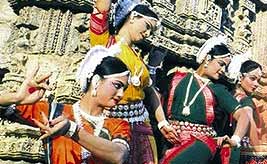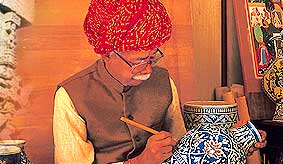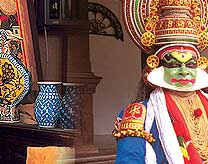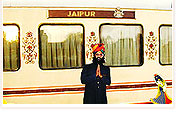Fairs and Festivals
Amarnath Yatra - Jammu & Kashmir :
In the month of Shravan, thousands of pilgrims make an arduous trek up to the Amarnath cave in the Kashmir Himalayas. They come to worship the sacred ice lingam - a symbol of Lord Shiva, which is a natural phenomenon.
Baisakhi - Punjab (April 14th)
A rural festival of North India, marking the beginning of the solar year (New year), celebrated in Punjab with great fervour. For the Sikhs the day is a collective celebration of New Year along with the commemoration of the founding of the Khalsa Panth (Sikh brotherhood) by Guru Gobind Singh in 1699.
It also signifies the end of harvest of the main crop. During Baisakhi the farmers give 'thanks' to the Lord Almighty for their fortune and pray for a better crop the next year. Baisakhi involves a lot of socialising where friends and relatives are invited and delicious meals are served.
The holy book of the Sikhs, 'Granth Sahib' is taken in a procession, led by the 'Panj Pyaras' (five senior Sikhs) who are symbolic of the original leaders. The occasion is celebrated with great gusto at Talwandi Sabo, where Guru Gobind Singh stayed for nine months and completed the recompilation of the Guru Granth Sahib and in the Golden temple in Amritsar. On Baisakhi day, water is drawn from all the sacred rivers of India and poured in to the huge tank surrounding the golden temple.
Budh Purnima - All over India
Buddha Poornima, which falls on the full moon night in the month of Vaisakha (either in April or May), commemorates the birth anniversary of Lord Buddha, founder of Buddhism, one of the oldest religions in the world. Notwithstanding the summer heat (the temperature routinely touches 45 degrees C), pilgrims come from all over the world to Bodh Gaya to attend the Buddha Poornima celebrations. The day is marked with prayer meets, sermons on the life of Gautam Buddha, religious discourses, continuous recitation of Buddhist scriptures, group meditation, processions, worship of the statue of Buddha and symposia. The Mahabodhi Temple wears a festive look and is decorated with colourful flags and flowers. Celebration of this festival has been recorded by the Chinese scholar, Fa-Hien.
Christmas - All Over India
Christmas the birth anniversary of Jesus Christ, is celebrated in India with great fervor all over India by the Christians.
People decorate their houses, erect Christmas trees, make cribs with figures of baby Jesus, Mother Mary, Joseph, the three kings who come to visit the baby and shepherd boys and their herds grazing around depicting the scenes of Jesus's Birth in the Bible. They decorate the Christmas tree, hang stars, gifts and illuminate them. On the Christmas day, people enjoy a sumptuous Christmas lunch. Christmas cakes and wine are served to visitors and exchanged as gifts among friends and relatives.
Christmas celebrations vary in different parts of India. In some parts, small clay oil-burning lamps, mango leaves etc are used as Christmas decorations and mango and banana trees are decorated. All the major Indian cities wear a festive look. Shops and bazaars are decorated for the occasion and offer attractive bargains. Carol singing, get-togethers and the exchanging of gifts enhance the Christmas spirit. Christmas parties launch off celebrations for the New year, thus retaining the festive mood for at least a week.
Durga Puja - West Bengal

Durga Puja In West Bengal Navratri is celebrated as Durga Puja where beautifully decorated images of the goddess are worshipped in specially erected Puja Pandals. Community pujas in Bengal are organised in every locality. Families visit each other to share feasts. On the final day the idols are taken in elaborate processions to be immersed in the river or the sea.
 Dussehra - All over India
Dussehra - All over India
Dussehra This Hindu festival is celebrated all over India to mark the defeat of Ravana by Lord Rama. Dussehra symbolises the triumph of good over evil. The 'Ramlila' - an enactment of the life of Lord Rama, is held during the nine days preceding Dussehra. On the tenth day, larger than life effigies of Ravana, his son and brother -Meghnath and Kumbhakarna, are set alight.
In Himachal Pradesh, a week -long fair in the hill town of Kullu, is a part of the Dussehra celebrations. From the little temples in the hills, deities are brought in procession to the 'maidan' in Kullu, to pay homage to the reigning deity, Raghunathji. In Mysore, South India the Mysore palace is illuminated for a whole month during Dusshera and caparisoned elephants lead a colourful procession through the gaily-decorated streets of the city. A torch light parade and dance and musical events enliven the tranquil city.
Diwali
Diwali, or Deepavali, perhaps the best-known Hindu festival, marks the end of the season that opens with Dussehra. Diwali is celebrated throughout India, as well as in Indian communities throughout the diaspora. It usually takes place eighteen days after Dusshera in October/November. Diwali is called the "festival of lights", and the name itself means an array of lamps (Deep = Lamp, Vali =Array). Indeed, illumination is characteristic of Diwali.
The array of lamps are symbolic of welcoming Lord Rama back to Ayodhya after his 14 years of exile, and the common practice is to light small oil lamps, diyas, and place them around the house. Diwali is celebrated for five continuous days and each day has its significance with a number of myths, legends and beliefs. The first day is Dhanteras. The word dhan means wealth, and as such, this day has special significance for the rich mercantile community (especially of Western India). Believing this day to be auspicious, women purchase some gold or silver or new utensils. The second day is Narka Chaturdashi or Choti Diwali. This commemorates the victory of Lord Krishna over the demon king Narakasur, or the divine over the mundane.
A traditional oil bath before sunrise is a must, especially in Maharashtra. The third day is the most important day of Lakshmi Puja or Chopda Puja. This day is regarded as the most auspicious. It is believed that on this day Lakshmi walks around and showers her blessings on man for plenty and prosperity. One of the most curious customs, especially in North India, is the practice of gambling on a large scale. It is believed that goddess Parvati played dice with her husband, Lord Shiva, on this day and she decreed that whoever gambled on Diwali night would prosper throughout the ensuring year. The fourth day is Padwa or Varshapratipada, which marks the coronation of King Vikramaditya. Vikram Samvat, the Hindu calender, was started from this day. This day is regarded as the start of a new year according to the Hindu calendar. This day is looked upon as the most auspicious day to start any new venture. The fifth and final day is called Bhaiya Duj in the Hindi-speaking belt and Bhau Beej in the Marathi-speaking community.
Like Raksha Bandhan, it is a day for brothers and sisters, and on this day, brothers go to their sisters' houses for a special meal. In South India and in the business community, Diwali is more associated with Lakshmi, the goddess of wealth and the consort of Lord Vishnu, the preserver in the Hindu pantheon. In rural areas, it is celebrated mainly as a harvest festival. If there is one occasion that is full of joy and jubilation for all, it is Deepavali. Homes are spring-cleaned and decorated. Even the humblest of huts is lit by a row of earthen lamps. Celebration is invariably accompanied by the exchange of sweets and the explosion of fireworks. Multi-coloured rangoli designs and floral decorations adorn the entrance of most homes. South Indians start their day with an oil bath. Diwali has the same importance for Hindus as Christmas does for Christians.
Ellora Festival - Maharashtra
It is a festival of dance and music held every March in the splendid surroundings of the world-heritage listed cave temple of Ellora, about 30 km from Aurangabad, Maharashtra. There are 34 caves cut out of the sloping side of the Chamadri hills. Excavated between 600-1000 AD, the caves belong to Buddhists, Jain and Hindu faiths. Ellora represents some 300 years of experiments carried out by different faiths with their very different iconography and structural compulsions. The archeological Survey of India has discovered another 28 caves later. The masterpiece of Ellora is the Kailash Temple. It is the world's largest monolithic sculpture, sculpted out of a rock by 7000 labourers over a 150-year period. This festival showcases the best talents and is a unique and charming way to experience the magnificent caves, imbibing centuries of history and culture. This Festival is organised by Maharashtra Tourism Development Corporation (MTDC) where India's renowned artists perform their talents in music and dance with the caves forming a splendid backdrop.
Ganesh Chaturthi - Maharashtra, Tamil Nadu, Andhra Pradesh, Kerala
Ganesh Chaturthi Ganesh or Vinayaka Chaturthi is dedicated to Lord Ganesh (son of Shiva), the elephant -headed god of all good beginnings and success. The festival celebrated as the birth day of Lord Ganesha, held annually in South India especially with great fervor in Maharashtra, is a ten day long event. On the occasion of the Ganapati festival, a large number of idols are made of clay or metal in all possible sizes sometimes even up to twenty feet. People buy them and install them in their houses and worship the idol for one to ten days, after which the idol are taken out ceremoniously, carried in a procession through the streets of the town (especially in Maharashtra) and immersed into the river, sea or well. The sea front at Mumbai, packed with people, is a spectacular sight. A cultural feast is held to coincide with Ganesh Chaturthi in Maharashtra especially at Pune. Classical dance, music performances, poetry recitations, folk dances, theatre and film festival are the main features of this festival.
Id-ul-Zuha (Bakr-Id) - All over India
This Muslim festival of sacrifice, Id-ul-Zuha (Arabic) or Bakrid in India is celebrated all over the country. On this day Muslims sacrifice a goat or Bakr (Urdu) to commemorate the sacrifice of Prophet Ibrahim, who willingly agreed to kill his son at the behest of God. This festival coincides with the Haj pilgrimage in Mecca. Prayers are offered in the mosques and the sacrificial meat is then distributed after the Id prayers. Special delicacies are prepared and served among family and friends on the occasion.
Janmashtami - All over India
The birth anniversary of Lord Krishna, the incarnation of Vishnu is celebrated with great fervour all over India especially at Mathura and Brindavan where Lord Krishna spent his childhood. Temples and homes are beautifully decorated and lit. Nightlong prayers are offered and religious hymns are sung in temples. The priests chant holy mantras and bathe the idol with Gangajal (water from the holy Ganges river), milk, ghee (clarified butter), oil, and honey pouring all these from a conch shell. In Maharashtra, earthen pots of curd and butter are hung up over the streets. Young men enacting an episode from Krishna's childhood form human pyramids by climbing on each other's shoulders and try to break these pots. Mathura, the birthplace of Lord Krishna, has about 400 temples dedicated to him. The main celebrations are held at the Dwarkadhish temple, Banke Bihari, Rangaji, Shri Krishna Balram temple and Gopinath temple. In South India, Janmashtami or Gokulashtami, is celebrated with prayers, devotional renditions and offering of fruits and special prasadams to Lord Krishna. In some houses, a typical setting of 'Gokulam' is arranged with mud images of Devaki, Vasudeva with little Krishna perched in a basket on his head, a cow, besides other things related to Krishna's legends.
Lohri - Punjab, Delhi
In the North Makar Sankranti is called Lohri. Lohri is the time after which the biting cold of the winters begins to taper off. On this day children go from door to door to collect funds for community bonfires which are lit up in the evening. Lohri is more of a community festival as people gather around the bonfires and offer sweets, crisp rice and popcorn to the flames.
Mahashivratri - All over India
On this day, the great night of the Lord Shiva, devotees stay awake throughout the night offering prayers to Lord Shiva. They offer special food made from the fruits of the season, root vegetables and coconut to the Lord. Special celebrations are held in some of the major Shiva temples at Varanasi, Kalahasti (Andhra Pradesh) and Chidambaram (Tamil Nadu)
Pushkar Fair - Pushkar, Rajasthan

This fair is held at Pushkar town, 11 km from Ajmer in Rajasthan for twelve days annually. This cultural and trade cum religious fair is an attractive and lively spectacle with Rajasthani men and women in their colourful traditional attire, saffron-robed and ash smeared Sadhus (holy men) and thousands of bulls, cows, sheep, goats, horses and camels in richly decorated saddles. Perhaps the largest cattle fair in the world, it attracts more than one lakh people, from all over Rajasthan as well as tourists from different parts of India and abroad.
Trading of cattle, camel races and dazzling displays of bangles, brassware, clothes, camel saddles and halters make the fair colourful. Necklaces of glass beads from Naguar, pottery, printed textiles from Jodhpur and Ajmer are all on sale here. Farmers, cattle traders and breeders buy and sell their animals, leather whips, saddles etc. There are facilities for camel rides also. This livestock fair coincides with the climaxing of a religious celebration. Pushkar is among the five main places of pilgrimage mentioned in the Hindu scriptures. It has a large number of temples including one of the only two temples dedicated to Lord Brahma in India. Hundreds of thousands of devotees take a ritual dip in the holy Pushkar lake on the day of the Kartik Purnima (full moon night of the Kartika month) and worship at the Brahma temple (Jagat Pita Shri Brahma Mandir). Pilgrims flock from all over India to be in Pushkar at this auspicious time. They also believe that all the 330 million Gods and Goddesses are present at Pushkar Lake during the occasion.

Apart from the religious rituals and trading, people participate in a number of cultural and sporting events. The sweeping expanse of the desert becomes dotted with thousands of camels, stalls and camping families. The Rajasthan tourism Development Corporation has taken adequate measures to facilitate convenient access of the fair site and to accommodate the fairgoers.
Raksha Bandhan - North India

Raksha Bandhan Sravani is an ancient Vedic festival traditionally associated with the Brahmins on which day they change their sacred thread. Both Raksha Bandhan and Sravani are celebrated on the full moon day of the month of Shravan (August). Raksha Bandhan or Rakhi the more popular of the two festivals, is a Hindu sister's day when brothers and sisters reaffirm their bonds of affections. Sisters tie colourful threads or rakhis on their brother's wrists. The brothers in turn promise to protect their sisters and give them gifts. Raksha Bandhan is celebrated in different forms in different areas and it is also known by the names like rakhi, rakhri and saluno.
Ramnavami - All over India
The birthday of Lord Rama, the celebrated hero of the famous epic, 'Ramayana', is enthusiastically celebrated on the ninth day of the waxing moon in the month of Chiatra, all over India. Lord Vishnu is worshipped in his human incarnation as Rama, the divine ruler of Ayodhya. Celebrations begin with a prayer to the Sun early in the morning. At midday, when Lord Rama is supposed to have been born, a special prayer is performed. People sing devotional songs in praise of Rama and rock, images of him in a cradle to celebrate his birth. Rathyatras or chariot processions of Ram, his wife Seeta, brother Lakshman and devotee Hanuman are held from many temples. People gather in thousands on the banks of the sacred river Sarayu for a dip. Some observe a strict fast on this day. Ayodhya is the focus of great celebrations. Devotees throng the temples of Ayodhya and Pondicherry, two places closely connected with the events of the Ramayana to participate in Ramnavami festivities.
Vasant Panchami, Saraswati Puja - North India and West Bengal
Vasant Panchami is the ceremonial welcome of the spring season in the month of Magh from the Hindu Lunar Calendar. This is a special day of worship for Hindu deities Saraswati, Shiva-Durga, Vishu-Lakshmi. People wear colourful attires, especially in bright shades of yellow and they dance, sing and make merry. In West Bengal "Saraswati" - the goddess of learning is worshipped. The festival is celebrated with fervour in the University town of Shanti Niketan.








 Durga Puja In West Bengal Navratri is celebrated as Durga Puja where beautifully decorated images of the goddess are worshipped in specially erected Puja Pandals. Community pujas in Bengal are organised in every locality. Families visit each other to share feasts. On the final day the idols are taken in elaborate processions to be immersed in the river or the sea.
Durga Puja In West Bengal Navratri is celebrated as Durga Puja where beautifully decorated images of the goddess are worshipped in specially erected Puja Pandals. Community pujas in Bengal are organised in every locality. Families visit each other to share feasts. On the final day the idols are taken in elaborate processions to be immersed in the river or the sea. Dussehra - All over India
Dussehra - All over India  This fair is held at Pushkar town, 11 km from Ajmer in Rajasthan for twelve days annually. This cultural and trade cum religious fair is an attractive and lively spectacle with Rajasthani men and women in their colourful traditional attire, saffron-robed and ash smeared Sadhus (holy men) and thousands of bulls, cows, sheep, goats, horses and camels in richly decorated saddles. Perhaps the largest cattle fair in the world, it attracts more than one lakh people, from all over Rajasthan as well as tourists from different parts of India and abroad.
This fair is held at Pushkar town, 11 km from Ajmer in Rajasthan for twelve days annually. This cultural and trade cum religious fair is an attractive and lively spectacle with Rajasthani men and women in their colourful traditional attire, saffron-robed and ash smeared Sadhus (holy men) and thousands of bulls, cows, sheep, goats, horses and camels in richly decorated saddles. Perhaps the largest cattle fair in the world, it attracts more than one lakh people, from all over Rajasthan as well as tourists from different parts of India and abroad. Apart from the religious rituals and trading, people participate in a number of cultural and sporting events. The sweeping expanse of the desert becomes dotted with thousands of camels, stalls and camping families. The Rajasthan tourism Development Corporation has taken adequate measures to facilitate convenient access of the fair site and to accommodate the fairgoers.
Apart from the religious rituals and trading, people participate in a number of cultural and sporting events. The sweeping expanse of the desert becomes dotted with thousands of camels, stalls and camping families. The Rajasthan tourism Development Corporation has taken adequate measures to facilitate convenient access of the fair site and to accommodate the fairgoers.  Raksha Bandhan Sravani is an ancient Vedic festival traditionally associated with the Brahmins on which day they change their sacred thread. Both Raksha Bandhan and Sravani are celebrated on the full moon day of the month of Shravan (August). Raksha Bandhan or Rakhi the more popular of the two festivals, is a Hindu sister's day when brothers and sisters reaffirm their bonds of affections. Sisters tie colourful threads or rakhis on their brother's wrists. The brothers in turn promise to protect their sisters and give them gifts. Raksha Bandhan is celebrated in different forms in different areas and it is also known by the names like rakhi, rakhri and saluno.
Raksha Bandhan Sravani is an ancient Vedic festival traditionally associated with the Brahmins on which day they change their sacred thread. Both Raksha Bandhan and Sravani are celebrated on the full moon day of the month of Shravan (August). Raksha Bandhan or Rakhi the more popular of the two festivals, is a Hindu sister's day when brothers and sisters reaffirm their bonds of affections. Sisters tie colourful threads or rakhis on their brother's wrists. The brothers in turn promise to protect their sisters and give them gifts. Raksha Bandhan is celebrated in different forms in different areas and it is also known by the names like rakhi, rakhri and saluno.